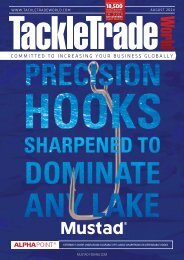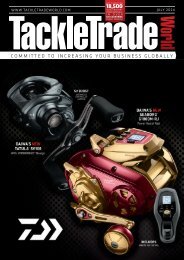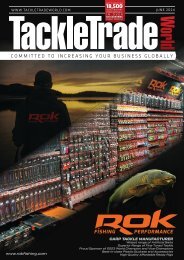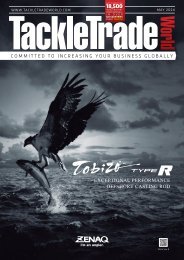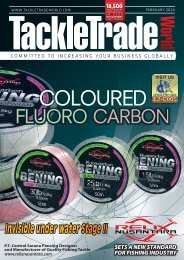Create successful ePaper yourself
Turn your PDF publications into a flip-book with our unique Google optimized e-Paper software.
SPOTLIGHT ON...<br />
LURES<br />
A HARD CHOICE<br />
Let’s take a look at some of the most common<br />
styles or types of lure…<br />
Plugs or crankbaits<br />
These are hard plastic fishing lures shaped<br />
and coloured to resemble bait fish or<br />
other prey, made out of a solid or hollow<br />
piece of plastic, with a thin lip of metal<br />
or plastic attached to the front, hugely<br />
popular with bass and pike anglers<br />
The lip is often adjustable to make the<br />
lure wobble. Plugs feature two or three<br />
treble hooks and can float, sink, dive, or<br />
hover.<br />
Most plugs float on the water’s surface<br />
or suspend in the water, but dive sharply<br />
when retrieved, so by reeling, stopping<br />
and repeating you can imitate the<br />
behaviour of live, or injured bait fish.<br />
Changing twitching intervals and<br />
reeling speed adds variety.<br />
Jigs<br />
Jigs feature a weighted head on one side<br />
and a hook on the other. Often using<br />
a plastic grub, jigs are one of the most<br />
popular types of fishing lures. They sink<br />
easily, making them great for bottom<br />
feeders – cast one out and let it sink to<br />
the bottom, then start jigging! The trick<br />
here is to experiment with different<br />
speeds and movements to see what works<br />
best.<br />
Spinners<br />
These move horizontally through the<br />
water, come in many shapes and colours<br />
– depending on the targeted depth and<br />
species – and have a hook on one side,<br />
and one or more metal blades that spin<br />
like a propeller on the other.<br />
The spinning blades vibrate, flash and<br />
reflect colour to accurately mimic bait<br />
fish and attract predators, making them<br />
perfect for catching bass, perch and pike.<br />
Spoons<br />
These may seem like a basic lure but, in<br />
the right hands, these curved, concave<br />
metal lures that shine and wobble as they<br />
move through the water, are deadly.<br />
The bigger the curve, the wider the<br />
wobble. A wobbling lure resembles<br />
injured bait fish, and this is something<br />
game fish can’t resist.<br />
Soft plastics<br />
Soft plastic lures imitate a variety of aquatic<br />
‘bait’, from minnows to worms, crawfish to<br />
frogs. Soft plastics are very popular for bass<br />
fishing.<br />
Their beauty is that they seem to work<br />
everywhere and the vast choice across the<br />
world is due to the fact that no one single<br />
lure will catch fish in all conditions on the<br />
day.<br />
There are designs for fast water, coloured<br />
water, dark days, light days and all the<br />
seasons of the year when fish behaviour and<br />
even species-specific behaviour has to be<br />
taken into consideration.<br />
STOCK REQUIREMENTS<br />
Many lure anglers who fish nothing else<br />
will have hundreds or possibly thousands of<br />
lures in various types to choose from. These<br />
will also vary depending on the country<br />
you’re in, although what generally pushes<br />
the buttons of a fish in Europe will also do<br />
so in North America or Australia.<br />
Understanding the waters near your store<br />
and the resident predatory species will make<br />
your stock choice easier but ask questions<br />
of your customers too and find out what the<br />
‘killer’ lures are in your area or region.<br />
www.tackletradeworld.com<br />
19





